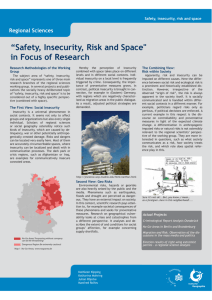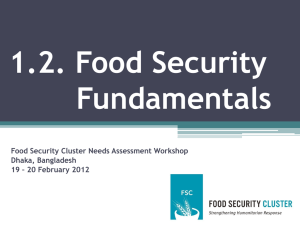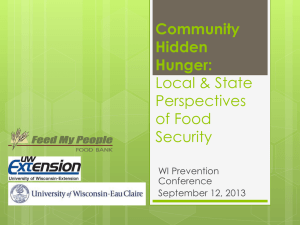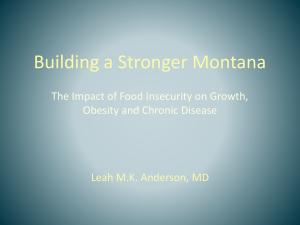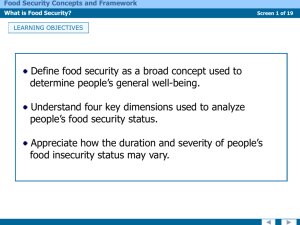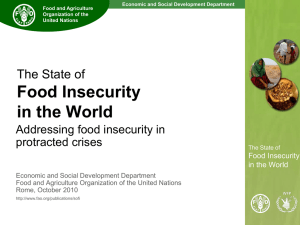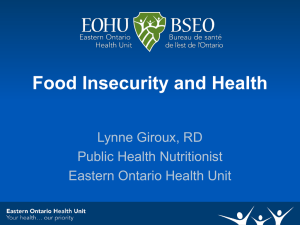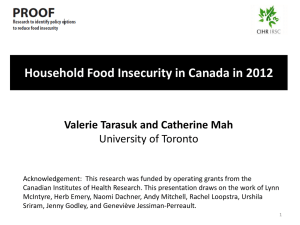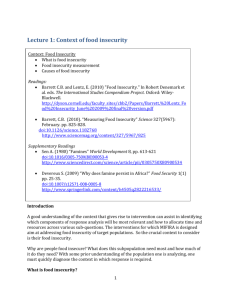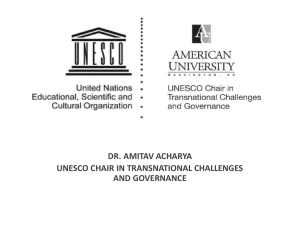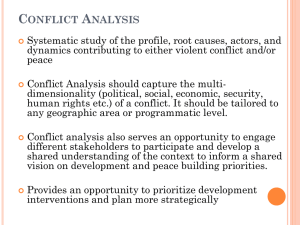1 Context
advertisement
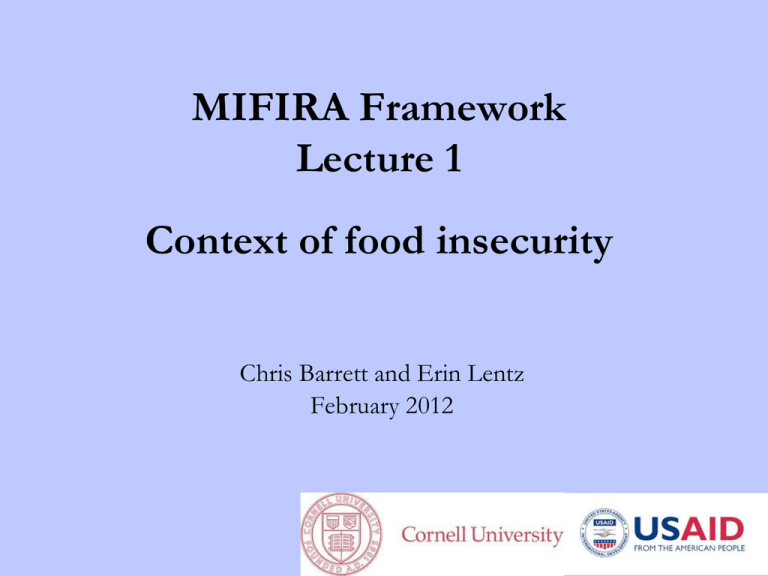
MIFIRA Framework Lecture 1 Context of food insecurity Chris Barrett and Erin Lentz February 2012 Overview Setting the context for MIFIRA: Food insecurity • Food Security: What is it? • Measures of food insecurity • Causes of food insecurity 2 Food Insecurity: What Is It? Knowing the population one is analyzing, next assess context: why are people food insecure? 1996 WFS definition of food security: “a situation that exists when all people, at all times, have physical, social and economic access to sufficient, safe and nutritious food that meets their dietary needs and food preferences for an active and healthy life.” 3 Food Insecurity: What Is It? Typically thought of as having 3 pillars: 1) Availability 2) Access 3) Utilization ( sometimes 4) Stability ) These are inherently hierarchical. Each is necessary but not sufficient for the one beneath it. 4 Food Availability Supply side … FAO food balance sheets 5 Food Access At least since Sen (1981), access is recognized as the dominant explanation for food insecurity. “Starvation is the characteristic of some people not having enough food to eat. It is not the characteristic of there being not enough food to eat. While the latter can be a cause of the former, it is but one of many possible causes.” Access reflects demand side: endowments (land, income) and exchange possibilities (prices/wages, 6 transfer options, safety nets based on rights) Food Access Incomes and prices are 1st order important to access. 7 Utilization Do individuals and households make good use of the food to which they have access? Do they consume nutritionally essential foods they can afford or do they choose a nutritionally inferior diet? Are the foods safe and properly prepared, under sanitary conditions, so as to deliver their full nutritional value? Is their health such that they absorb and metabolize essential nutrients? 8 Stability 4th pillar? Captures the susceptibility of individuals to food security due to interruptions in access, availability or utilization. Matters for targeting of interventions and the design of safety nets intended to safeguard food security for vulnerable subpopulations. Introduces concepts of risk and time. 9 Stability Food price instability of particular concern. 10 Chronic and Transitory Food Insecurity Chronic food insecurity reflects a long-term lack of access to adequate food, and is typically associated with structural problems of availability, access or utilization. This is by far the most widespread sort of food insecurity. Transitory food insecurity is associated with sudden and temporary disruptions in availability, access or, less commonly, utilization. 11 Seasonal Food Insecurity 2 common sorts of transitory food insecurity: Seasonal – recurs annually during the hungry season before the next main harvest comes in. Prices rise. Commonly affects the rural poor. Source: Stephens and Barrett, 2011 12 Famines Old view: Malthus and supply-side explanations for mass mortality food crises: Food supply declines below point where adequate nutrients available to meet everyone’s needs. Sen view: “entitlements” collapse, due to income collapse (unemployment), price spikes, etc. not just supply side shocks. 21st century view: multifactoral causality, but mainly a failure of political will: information adequate to prevent. 13 Measures Lots of different measures exist. Reflect different concepts and data sources. Examine critically. Measurement matters for three reasons: 1) By capturing different phenomena, subtly affect policy and project prioritization. 2) Data typically retrospective, but policy is aimed at affecting future. How predictive are measures? 3) Measures must be associated with targetable characteristics if interventions are to be properly directed to those most in need of assistance. 14 Causes of Food Insecurity In addition to the chronic/transitory distinction, it is helpful to separate covariate and idiosyncratic. Covariate: common to a broad subpopulation (e.g., due to crop yields, food prices, wages, civil unrest). Underpins generalized interventions (e.g., food aid, price controls, famine early warning systems). Idiosyncratic: individual-level experience (e.g., gender, religion, occupation, age, land holdings). Essential to successful targeting of interventions. 15 Causes of Food Insecurity Domestic production dwarfs commercial crossborder trade and food aid, so local productivity is key to chronic covariate food insecurity. Global Annual Cereal Flows 60 400 Production (read against right axis) 350 300 40 250 Commerical imports (read against left axis) 30 200 150 20 100 Ceral Production in kilograms per person Cereal Trade and Aid in kilograms per person 50 10 50 Food aid (read against left axis) 0 1970 0 1975 Source: FAO, FAOStat database 1980 1985 1990 Years 1995 2000 2005 16 Causes of Food Insecurity Because incomes are so strongly correlated with access, income is the best indicator of chronic idiosyncratic food insecurity. 60 25 50 20 40 15 30 10 20 5 10 0 0 0 5,000 10,000 % children <5 years stunted (ca. 2006) Child Stunting and Wasting, by National Income 30 15,000 Source: Barrett and Lentz (2010), Food Insecurity in Denemark ed. The International Studies Compendium Project. Oxford: Wiley-Blackwell. 17 Causes of Food Insecurity Transitory idiosyncratic food insecurity is commonly associated with livelihood disruptions: e.g., job loss, crop failure, livestock loss, etc. Formal and informal safety nets are crucial. Transitory covariate food insecurity is primarily associated with sharp adjustments in prices or, more broadly terms of trade (e.g., wage/price, livestock price/crop price) 18 Causes of Food Insecurity Market Access A big cause of both chronic and transitory idiosyncratic food insecurity. Can be due to: - excessive transactions costs (travel, information, storage, etc.) related to geography, physical health - social exclusion (gender, age, religion, race, etc.) - macro policies (FX rationing, trade barriers) 19
